David Romo - Paste 2013
advertisement
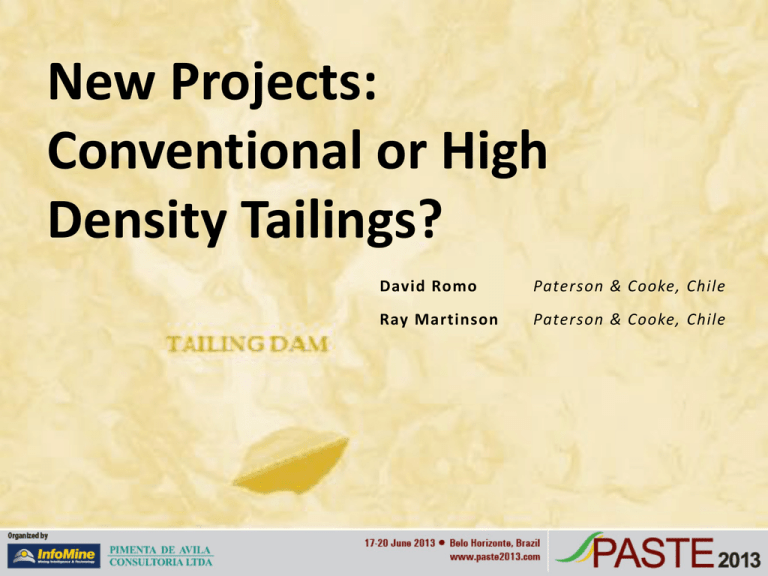
New Projects: Conventional or High Density Tailings? David Romo Paterson & Cooke, Chile Ray Martinson Paterson & Cooke, Chile The challenges of new mining projects Every new mining project has to define the most important aspects for the business: • Mineral resources model • Mine explotation design • Methallurgicall process After that, the main consumptions of the process have to be evaluated: • Water consumption • Energy consumption At the end, the projects have to define what to do with the waste of the process: • Sterile material • Tailings Aim of the study In this case Paterson & Cooke office in Santiago was in charge of the definition of tailings management system of the project. The aim of this presentation is to show the issues we had to face and what we did to deal with them, in order to support the definitions of the Client. “What we have to do is to look at the whole picture of the problem” Content 1. Project overview 2. Tailings deposit location 3. Bench scale tests 4. Conceptual trade off: conventional or thickened tailings? 5. Semi pilot test work 6. Reviewing the solution 7. Conclusion 1. Project Overview The study adresses a new project of Sociedad Punta del Cobre, the greatest medium copper mining company in Chile. • It is a gold-copper mine located at the IV region of Chile, around 300 km north of Santiago • It is located in a desert area, the annual rainfall is less than 200 mm. • The project considers a plant to process over 15,000 tpd • The tailings deposit considers a capacity over 100 million tonnes 1. Project overview Paterson & Cooke led a consulting team to design the tailings system for the project PROFILE PREFEASIBILITY TRANSITION STUDY STUDY ENGINEERING 2010 2011 FEASIBILITY STUDY 2012 2013 DEPOSIT LOCATION BENCH SCALE TESTS SEMI PILOT TESTS PRELIMINARY ARRANGEMENT CONCEPTUAL TRADE OFF UPDATE THE SOLUTION PATERSON & COOKE LED THE TAILINGS CONSULTING TEAM PUMPING TAILINGS SYSTEM DESIGN SUB-CONTRATOR OF AMEC CHILE CONSTRUCTION 2014-15 2016 COMMISIONING 2. Tailings Deposit Location • Based on satellite survey, 11 potential sites were identified closer than 30 km to the plant. Alt. 11 Alt. 10 • The storage target was 150 million tonnes. Alt. 8 • A comparison was done considering: Alt. 9 • Alt. 6 PLANT • Alt. 1 Alt. 5 Alt. 2 Alt. 4 Alt. 7 Alt. 3 • • Conventional tailings pumping head Recovered water pumping head Dam wall volume Existing human activity • Three alternatives were selected to complete the trade off comparison 2. Tailings Deposit Location The evaluation of each alternative considered: PLANT LOCATION • Storage capacity of 80 million tonnes Alternative 5 • Processing plant of 17,000 tpd Alternative 2 • Conventional tailings with 55%cw • Sand wall from cycloned tailings Alternative 4 The results were the following: Parameter Unit Alternative 2 Alternative 4 Alternative 5 Starting wall volume Mm³ 1.5 1.3 0.8 Final wall volume Mm³ 11.1 5.0 4.4 Final wall height m 102 81 85 Slurries and water pipeline length m 8.4 36.2 56.1 Total installed power kW 1,249 6,669 7,759 Plant make-up water m³/t 0.54 0.55 0.64 Due to lower Capex and Opex, lower installed power, best plant makeup water and lower environmental impact, Alternative 2 was selected. 3. Bench Scale Tailings Tests In order to get slurry design parameters, bench scale tests were done on samples of each UGM and on a composite. 100 from • The average p80 was 148 μm, 61% less than 75 μm and Sg of 3.03 % Passing • The samples were got metallurgical bench scale tests. Tailings Particle Size Distribution 90 SF UGM1 80 SF UGM2 70 SF UGM4 60 SF UGM5 50 SF UGM6 40 Composite Sample Sedimentation tests were done by Delkor: 30 • Magnafloc 338 was the best floculant, floc dose between 6-12 g/t and dilution of 13%cw 20 • Depending on the sample, a paste thickener could produce tailings between 68.5% - 74.1%cw, being the expected average equals to 71.5%cw. 10 0 1 10 100 Particle size (micron) 1000 3. Bench Scale Tailings Tests Bingham Yield Stress vs Solids Concentration 80 UGM1 (F) UGM2 (F) UGM4 (F) UGM5 (F) UGM 6 (F) Composite Sample (F) Design Curve 60 50 70 Yield Stress (Pa) 70 Yield Stress (Pa) Bingham Yield Stress vs Solids Concentration 80 40 30 60 50 30 20 10 10 67% 68% 69% 70% 71% 72% Solids Concentration (Cw) 73% 74% 75% 76% Maximum Rheology 40 20 0 66% Minimum Rheology 0 66% 68% 70% 72% Solids Concentration (Cw) 74% 76% • A range of rheology was measured in rotational viscometer. • The unsheared yield stress, for the expected operational thickening points, was determined between 15 and 40 Pa, which is considered a low rheology. • The rheology reduction was measured at 30%, so the expected fully sheared yield stress was between 10 – 28 Pa. At the average thickening point the expected fully sheared yield stress was 19 Pa. 3. Bench Scale Tailings Tests In order to estimate the beach slope at the deposit, a flume test was done on the composite sample. The limitations of flume tests for predicting beach slopes are well known, so the measured values were reduced by considering two reduction factors: evaluating the average slope in the middle of the flume and also considering a reduction of 30%. Estimated Beach Slope vs Yield Stress (Fully Sheared) Estimated Beach Slope (%) 6% Middle Profile Slope 5% 5.1% Recommended Curve 4% 3.6% 3% 2.2% 2% 1.5% 1% 0% 0 5 10 15 20 25 30 Yield Stress (Pa) 35 40 45 50 With those considerations, at the average fully sheared yield stress of 19 to 20 Pa at the deposit, a beach slope of 1.5% was estimated for the purpose of prefeasibility engineering 4. Conceptual Trade off: Conventional or Thickened Tailings? The main aspects to figure out in the project in terms of the prefeasibility study were as follows: • Deposit location • Tailings management system • Dam wall and storm water system design The dam wall and storm water system design were undertaken by Knight Piesold Chile. Two different options for tailings management system were evaluated: • Conventional tailings option: low density tailings, cyclons operation, slimes transport, tailings sand wall and tailings discharge at the deposit from the wall. • Thickened tailings option: high density tailings, wall constructed with borrowed material and tailings discharge at the end of the deposit. 4. Conceptual Trade off: Parameter Solids concentration Conventional tailings system 64%CW Thickened tailings system 70%CW Thickener (1) × Ø48 m high rate thickener, yield stress < 15 pa Gravitational flow through 4,300 m HDPE pipeline (1) × Ø48 m paste thickener, yield stress < 80 Pa Gravitational flow through 700 m HDPE pipeline Tailings transport Tailings classification Sand transport Slimes transport Recovered water transport Starting dam wall Final dam wall Beach slope Plant make-up water Installed power 3 + 3 cyclones 2 + 2 slurry pumps TDH 20 m Gravitational flow through 1,475 m steel pipeline 2 + 2 barge pumps and 4 + 2 water pumps TDH 230 m No cyclones or pumping slurries systems were considered 1.8 Mm³ 1.0 Mm³ 12.5 Mm³ 6.5 Mm³ 0.3% 1.5% 0.46 m³/t 0.40 m³/t 3,100 kW 1,700 kW 4. Conceptual Trade off The thickened tailings system was selected because of: • Lower capex • Lower installed power • Lower plant make up water • Lower volume of water within the deposit • Greater opportunities to improve the using of the deposit facilities Tailings discharge Plant Location Wall Thickener 5. Semi Pilot Tailings Tests • The p80 was 218 μm - 192 μm • Fine fraction less than 75 μm was 56%-60% Slurry behaviour tests were done by P&C Johannesburg: • Natural pH 7.8 • Slurry conductivity over 40 mS/cm (sea water) • Slurry naturally settling Particle Size Distribution - Semi Pilot Samples 100 90 80 70 60 50 40 30 20 10 0 M1 M2 % Passing Semi pilot tailings tests were done in order to improve the knowledge of tailings on a larger scale. 1 10 100 Particle size (micron) 1000 5. Semi Pilot Tailings Tests Semi pilot thickening tests were done by Outotec in a Ø190mm x 4 m thickener: • Magnafloc 338 was the one of the best floculants, floc dose grew up to 17 g/t and dilution was 12%cw • Optimum flux rate was 0.4 t/m².h • Expected U/F solids concentration 65%-73%cw • Unsheared yield stress between 50180 Pa • Two options were proposed: • • One 55Øm high compression thickener Two 38Øm high compression/paste thickeners 5. Semi Pilot Tailings Tests Bingham Yield Stress vs Cw 200 Bingham Yield Stress (Pa) 180 160 140 Sample 1 Fully Sheared Sample 2 Fully Sheared Sample 1 Unsheared Sample 2 Unsheared Paste 120 100 80 Thickened 60 40 20 Conventional 0 50% 52% 54% 56% 58% 60% 62% 64% 66% 68% 70% 72% 74% Solids Concentration (Cw) • A range of rheology was measured in rotational and tube viscometer. • A great difference between the rheology of both samples was measured. Even the rheology was 6 times greater than the measured one at the PFS study. • A rheology reduction of 60% was measured on these samples 5. Semi Pilot Tailings Tests Estimated Beach Slope vs Solids Concentration Estimated Beach Slope % 3,0% 2,5% 2,0% 1,6% Estimated Beach Slope M1 Estimated Beach Slope M2 Operational Point 1,5% 1,0% 0,5% 0,0% 64% 66% 68% 70% 72% 74% 76% Solids Concentration Cw % • 4 m flume tests were done to estimate the beach slope. The experience and test data analysis were done with the support of Professor Andy Fourie. • Both samples showed different behaviour, due to the different lithology. The beach slope estimation considered a safety factor of 50% over the measured slope. • At the average solids content for the thickener operation of 70%CW, the average beach slope was estimated on 1.6% 6. Reviewing the Solution 6.1 Tailings Pumping Because of the higher rheologies measured at semi pilot test work, pump stations are required for tailings transportation from thickener(s) to the deposit. Depending on the option of thickening circuit the pumping system is as follows: Pump station (1) × Ø55 m thickener (2) × Ø38 m thickener Underflow discharge (1 + 1) 20 m/15 m 250 kW centrifugal pumps 2 × (1 + 1) 20 m /15 m 200 kW centrifugal pumps Transport to deposit (1 + 1) 25 m/20 m 200 kW centrifugal pumps 6. Reviewing the solution 6.2 Filtered tailings Bench top filtering tests were done by Delkor, but the filtration rates were very poor for vacuum and pressure technologies. In spite of those results, an evaluation of filtered tailings system was done. The area of the deposit is not suitable to dispose tailings in stock piles. This is because of the maximum expected value for the hydrographic basin storm flow which reaches 211 m³/s. As a result, a water dam as well as an evacuation tunnel had to be considered in this evaluation. Finally the filtered tailings option resulted into a Capex over 2.4 times the thickened tailings option. 7. Conclusion The study developed for this new project of Sociedad Punta del Cobre ended into the following conclusions: • The site conditions are the most important aspects that define which type of dewatering system is the best. The topography and the hydrographic basin storm determine the design of the deposit and the tailings management system. The other very important aspect are the pumping distances. • If the material presents good conditions to be thickened or filtrated, a complete test plan must be done to support every engineering evaluation. Bench scale or pilot tests are recommended to be done for each stage of engineering. • In this case, thickened tailings clearly has technical advantages over conventional and filtered tailings systems. The expected plant make-up water is 0.4 m³/t and the installed power is 2,700 kW • For feasibility engineering, the final selection of the thickening circuit and the study of disposal strategies will be important issues to address. Acknowledgements We want to acknowledge to all people who worked with us, from Knight Piesold Chile, Multical, Delkor, Outotec, Mr. Andy Fourie and to Pucobre S.A.
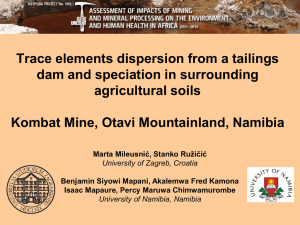
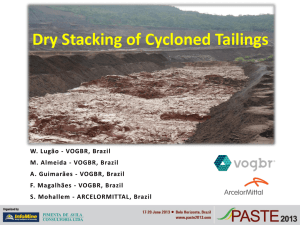
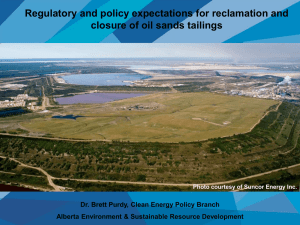

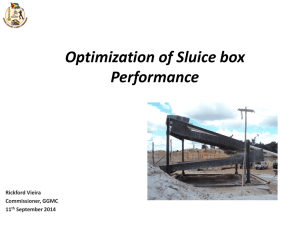

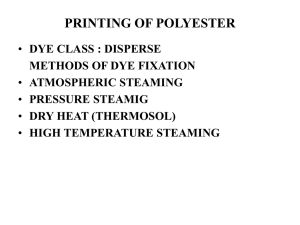


![PERSONAL COMPUTERS CMPE 3 [Class # 20524]](http://s2.studylib.net/store/data/005319327_1-bc28b45eaf5c481cf19c91f412881c12-300x300.png)
